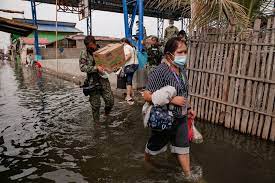Even without a typhoon— high tides, habagat and steady rainfall during the rainy season– much of Metro Manila and surrounding provinces go under flood because of the changing climate and the fact that many parts of Manila and suburbs are below sea level.
And for the third straight year, the country has remained the most at-risk from extreme natural events and negative climate change, said a 2024 edition of World Risk Report published by the Inquirer.
The World Risk Index, covering 193 United Nations (UN) member nations for the first time, assessed disaster risks by evaluating each country’s ‘exposure to natural hazards, the susceptibility of their population and coping or adaptive capacities of their societies.”
The Index had the Philippines topping with the highest risk (46.91 points), followed by Indonesia in second place (41.13), India in third (40.96), Colombia in fourth (37.81) and Mexico in fifth (35.93).
The remaining countries with the highest risk were Myanmar, Mozambique, Russian Federation, Bangladesh and Pakistan.
Meanwhile, Qatar was ranked as the safest country in the world from the dangers of natural disasters because of its geographical position, making it protected from tropical cyclones.
The index has been published annually by Bündnis Entwicklung Hilft and the Ruhr University Bochum–Institute for International Law of Peace and Armed Conflict since 2011.
Long-term risks
The result is calculated by getting the geometric mean of the country’s exposure and vulnerability according to 100 indicators, the report explained.
Exposure refers to the extent to which populations are exposed to and affected by earthquakes, tsunamis, floodings, cyclones, droughts and sea level rise.
Vulnerability, on the other hand, refers to a country’s likelihood to suffer from damages during natural disasters and its ability to respond quickly and in the long term.
The index “serves as a guidance for decision makers and identifies fields of action for disaster risk reduction,” the report said, as published on Bündnis Entwicklung Hilft’s website.
Environment Secretary Ma. Antonia Yulo Loyzaga said the Philippines, though affected by many natural hazards, was also “one of the fastest growing economies in the world [under the Marcos administration], with a steady population growth and declining poverty rate}. This explains our high exposure and vulnerability.”
She said the government is studying the report carefully but that “[we] have already been working strategically across departments and local governments, with development partners and the private sector, to build our capacity to protect these gains along with lives and livelihoods.”
Stark reminder
At the same time, the Office of Civil Defense (OCD) opined that the Philippines needs a multisectoral approach in disaster risk reduction and management.
The OCD stated that the country’s ranking in the report was “a clear reminder” to keep working together to tackle and address the challenges and issues at hand.
It pushed for collaborative interventions from different sectors “to promote more comprehensive and concrete efforts to reduce risks.”
Intact ecosystems like forest and riparian wetlands or mangroves can significantly reduce disaster risk by reducing the susceptibility towards extreme natural events. They contribute to nutrition, income and wellbeing. In addition to food, they can also provide medicine and building materials, or they can represent new sources of income, for example via eco-based tourism.
Meanwhile, extreme natural events can have considerable effects on the environment and cause damage for ecosystems. Cyclones can pull over thousands of trees and destroy coral reefs or floods can contribute to erosions and damage solum.
The destruction of the environment and its natural protective function in pursuit of economic interests increases the risk of disaster in the wake of extreme natural events.
Flooded coastal villages and washed away beaches whose natural protective belt of mangroves has been chopped down are just some examples among many others. This interaction between environmental destruction and disasters still gets too little attention by politics and science.
#WeTakeAStand #OpinYon #OpinYonNews #Surveys
